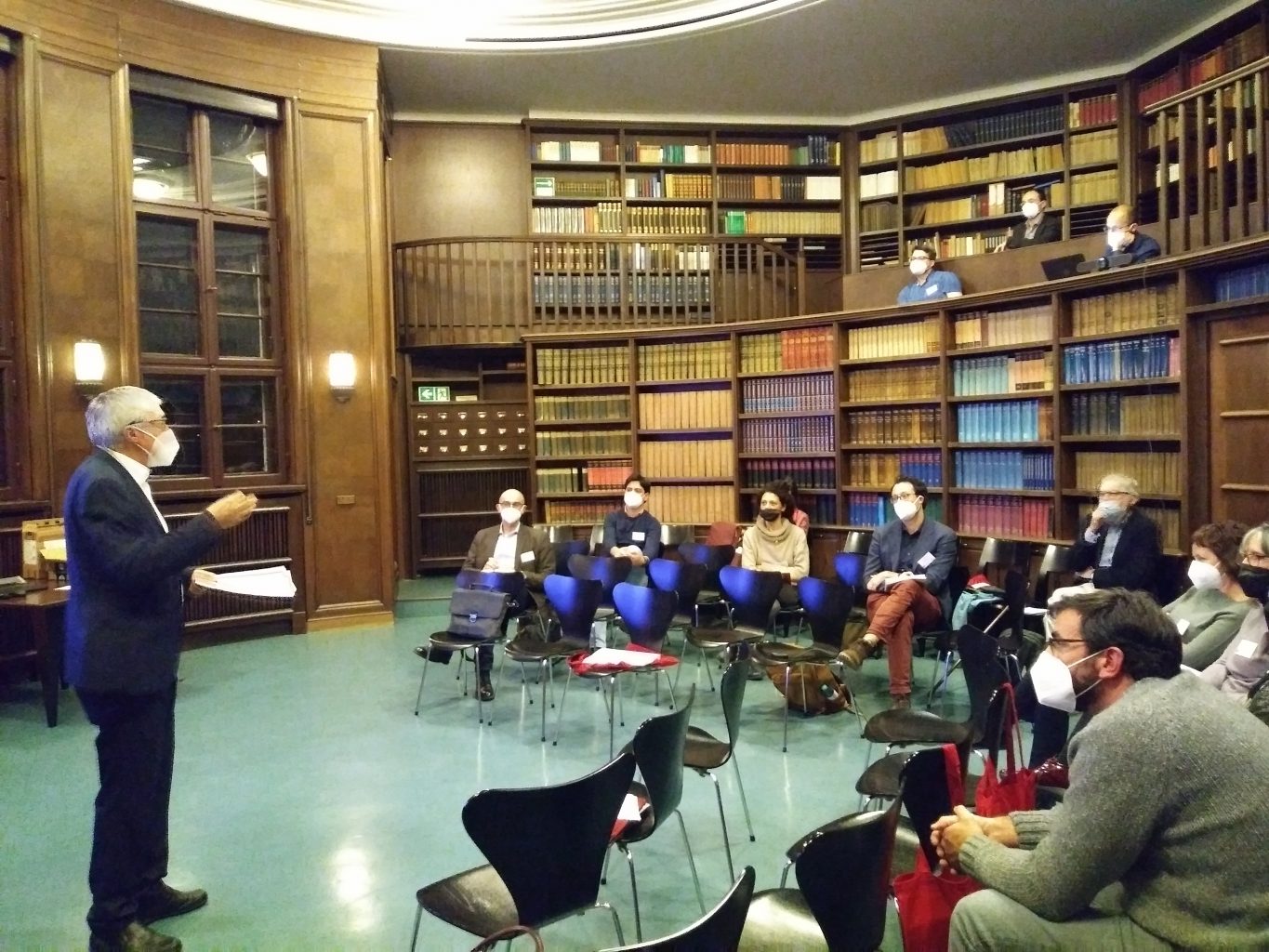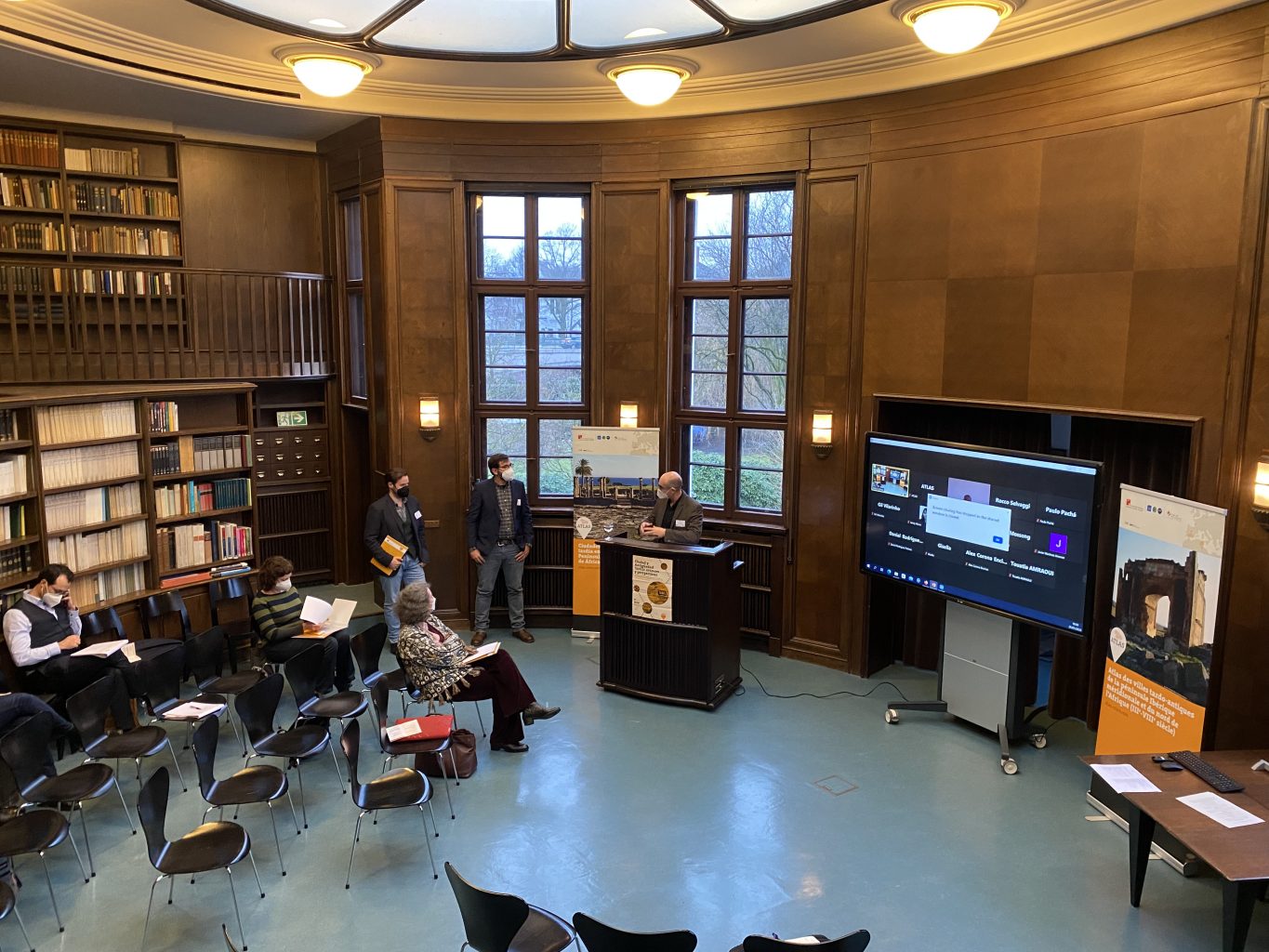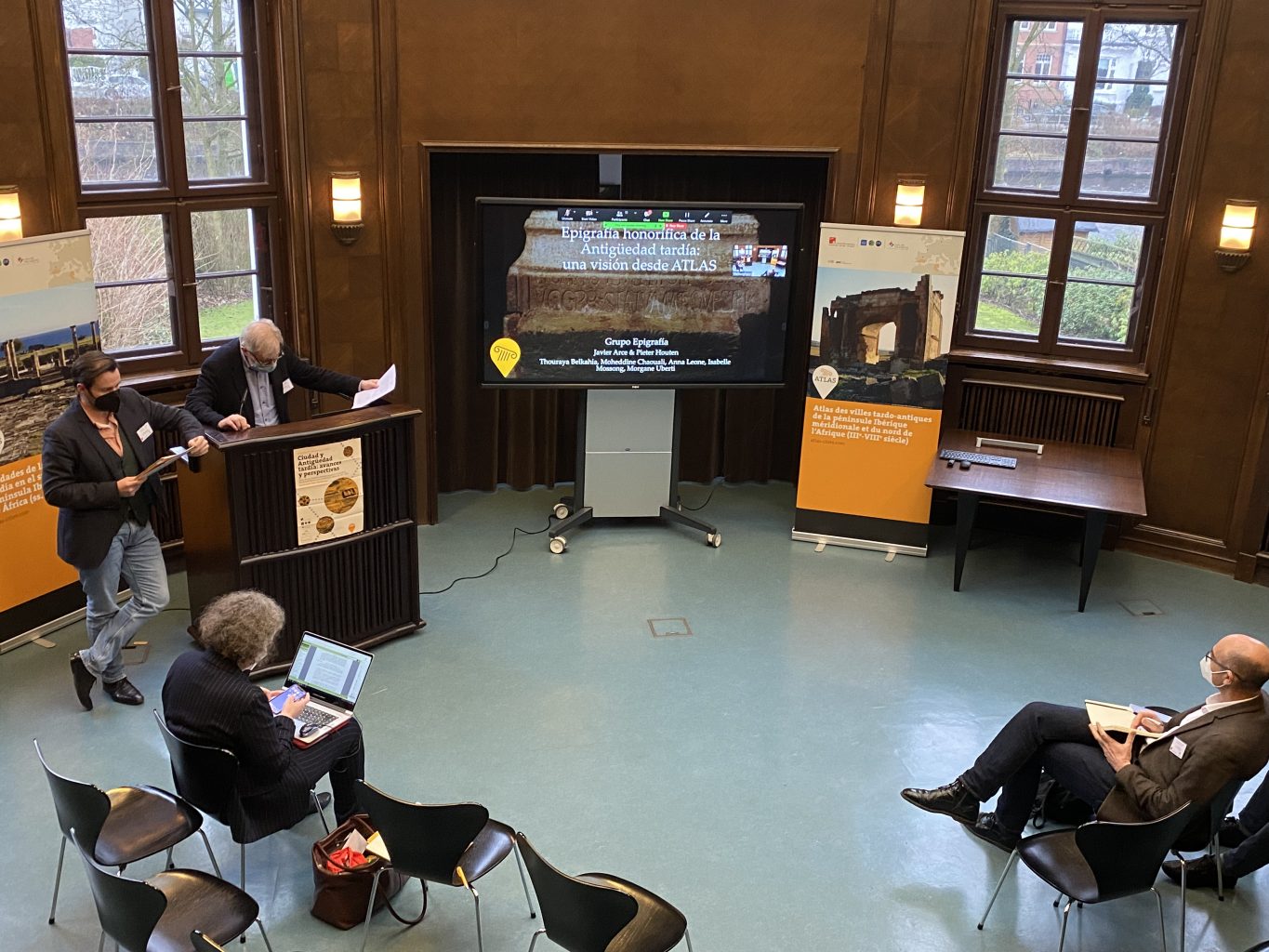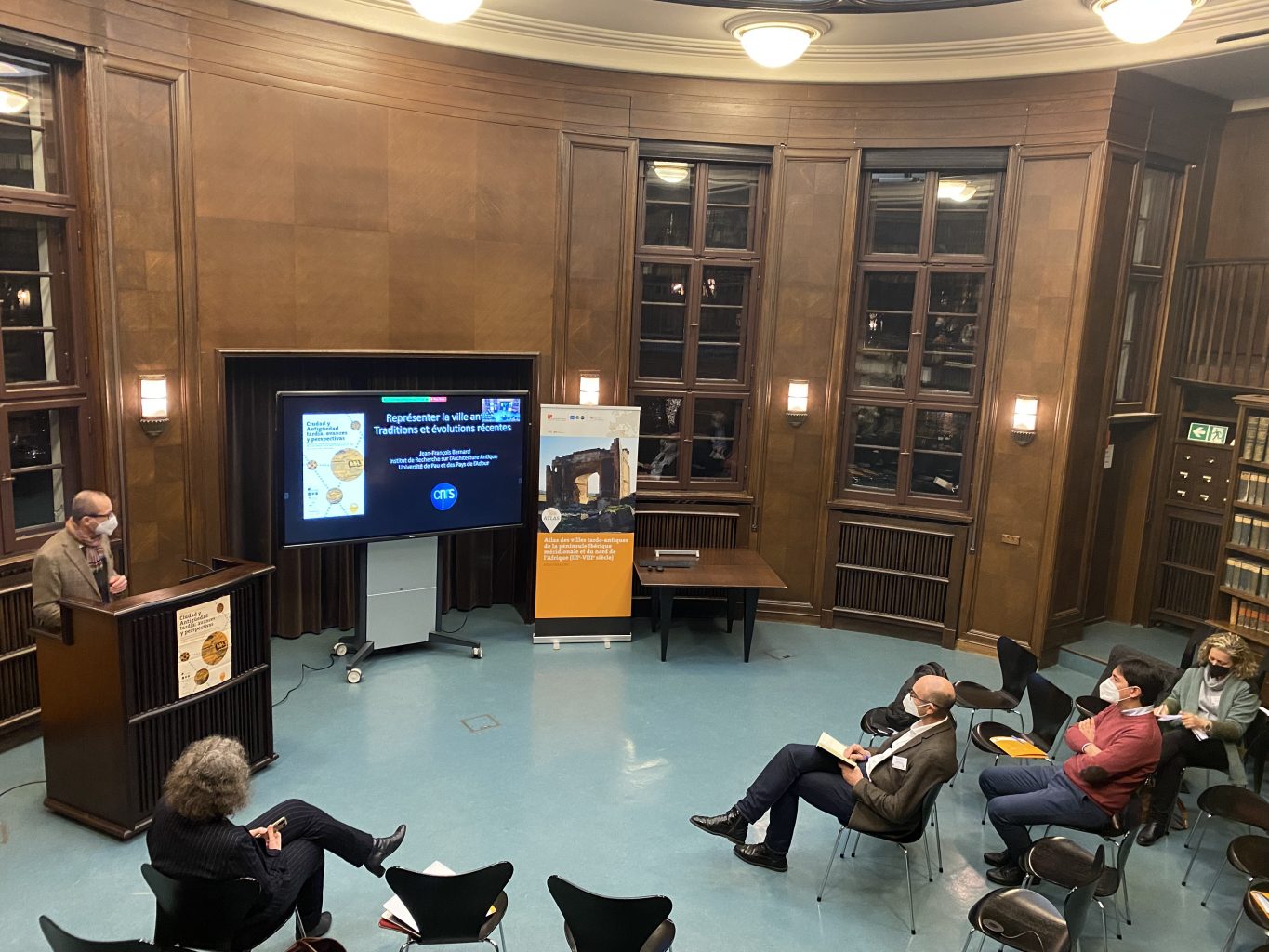From Monday the 24th of January to Wednesday the 26th we held the second ATLAS meeting with the title Ciudad y Antigüedad tardía: avances y perspectivas. We met in the reading room of the always impressive Kulturwissenschaftliche Bibliothek Warburg, or in short Warburghaus. Due to its oval lay-out the room creates the right ambience for exchange and discussion between the speakers and the audience, but also within the audience. As not all members were able to travel to Hamburg we held it in hybrid form. This way we had visitors connecting from far and wide, as far as Brasil, and being able to join the debates.

The title explains the aim of the meeting, discussing the advances and perspectives of the seven research groups. We divided the meeting into sessions for each group, where a key-note speaker from outside the project was invited to present on the topic of the group. This key-note was followed by a Work in Progress presentation of the research group. After both presentations we planned discussions of about 30 minutes. As always the discussions could have lasted much longer, as did some presentations 😉 Luckily we always had either coffee or lunch following the sessions, so there was room to continue in the breaks.
Monday, 24th January
The two directors opened the meeting in the standard ATLAS way and thereby indicating what the discussions would look like: Sabine opened in Spanish, whereas Laurent used French. Within the project most members speak at least one of these languages and understand the other. This way we were able to have discussions simultaneously in French and Spanish.

As part of our opening we invited Hervé Inglebert of the Université Paris Nanterre. He gave a magistral lecture on the position of the ATLAS project within the large debates. Starting his historiographical analysis with the earliest authors debating Late Antiquity, from Riegl and Strzygowski (1901) and worked his way to our time. Thereby bringing up the large problems we can encounter in our project. How are we treating our Long Late antiquity? What about the geographical scope? His conclusion was reassuring: The ATLAS project is positioned very well within the studies of Late Antiquity.

The first research group was Poder político y ciudad; they invited Javier Martínez Jiménez from the University of Cambridge. He first showed the changes in the urban settlement pattern in Visigothic Spain including the question: What is a city? Thereafter he turned to the politics behind these urban foundations. He pointed out that controlling certain areas could be one of the explanations for these foundations. However, by new foundations the king could create new elites and bind people to him.
For this group Javier Arce and Rubén Olmo turned their attention to the provincial governors and the cities in Hispania. They found that the evidence, epigraphic and textual, for governors is very scarce and does not allow to elaborate on the relation between city and governor. What can be observed is that the governors were mostly active within the capital cities: Tarraco, Emerita Augusta and Corduba. The question is raised whether a view from Africa would give us another picture.

We ended the first day, well afternoon of our meeting as we always do in the Warburghaus: with a reception. The small bites and drinks help to get the conveners to know each other and start the informal discussions. We need to mention the always friendly and helpful Frau Drößler, the silent power behind all food and drinks at the Warburghaus. Without her help we wouldn’t have such nice breaks in the Warburghaus.
Tuesday, 25th January
We started the second day with a brisk walk through the city under the excellent guidance of the local tour guide Dominik Kloss. We started our tour from the hotel and on our way to the city center we passed the RomanIslam center, and more importantly, the ATLAS office (a.k.a. Pieter’s office). Dominik explained us the development of Hamburg from its origins as a trading center at the confluence of the Elbe and Alster to the construction of the University building in 1911 and the foundation of the university in 1919.

We then started our morning session on Tuesday with the Forma de los espacios urbanos. The group invited Gisella Cantino Wataghin of the Università del Piemonte orientale. She presented a paper on the role of cities, especially smaller cities, in Late antique northern Italy. Her views on the changing settlement systems and internal structures and fortifications of the cities were a perfect fit with the group presentation.
Our ATLAS postdoc Ada Lasheras and Stefan Ardeleanu took care of the presentation of our largest research group. The research group clearly coordinated their work and provided a perfect side by side treaty of the changes we can observe in the late antique city. Their focus was on the reorganisation of the city and the new hierarchies resulting from these changes.

The afternoon sessions started with Julia Sarabia-Bautista, of the Universidad de Alicante, as the key-note for the Territorio group. She presented a longue durée view on the occupation of the territories around cities in the region around Alicante. She showed that the peri-urban areas often find multiple areas of occupation but mostly short term, possibly depleting the resources and then moving. Whereas the peripheral areas have a more continuous occupation, this raises the question whether these areas are more autarchic and sustainable.

Jesús García Sánchez gave a similar view on the territory of Emerita with new materials found through survey and legacy data. Our postdoc Pieter Houten added Africa by turning to Carthage and looking at legacy data approach based on the article by Sycamore and Buchanan. Since ATLAS uses already published materials the questions of legacy data are relevant. The resulting debate on how to define categories was helpful to the analysis of the different territories.

After a coffee with local Hamburgian cake, Frau Drößler always takes good care of us, it was time for the final session of the day: Economía.
From the University of Liverpool we invited Alfred Hirt to present his research on mining in Africa and the Iberian Peninsula in late antiquity. He spoke about the diminishing mining operations and searched for reasons to explain the decline. The often used argument that the mines were depleted is not true, mining continued later on. Fred argued for a combination of factors leading to diminishing returns, simply put, it became too expensive to run the mines. Part of the problem is the tying down of labour. This way the specialist miners could not move to new mining regions to start operations there. One of the points for discussion was brought in online via the numismatist Ruth Pliego and turned to the origin of the gold for minting in the northwest in Late Antiquity.

The economy group focussed on three economic topics: Darío Bernal presented the fishing operations in the Straight of Gibraltar and the intertwining of Hispania and Africa. Thereafter he took over for Jaime Vizcaíno to consider the economic position of Carthago Nova and the reuse of former public areas for workshops. Touatia Amraoui examined the fishing activities in Leptiminus, as well as the production (kilns) of amphorae for wine and olive oil. However, the production sites for wine and olive oil in the hinterland are not found yet. Similarly in Carthage the kilns have been located, but not related to rural production.

We closed the day with a lovely local dinner at Broderson, which cannot be left out in a Hamburg meeting. The Labskaus frightens those that do not know how amazing this local dish is. Every time we manage to convert just a few lucky souls.
Wednesday, 26th January
Last day, last century. The key-note for Siglo VIII by Carolina Doménech Belda, of the Universidad de Alicante, presented a paper on coins and seals from the time of the Arab-Berber conquest in North Africa and the Iberian Peninsula. Among the most recent findings are the seals, which are linked to the payment of tribute and have been especially found in the south of Hispania and in the Narbonensis. She also presented the evolution of the so-called ‘coins of conquest’, a gold coinage that presents linguistic changes but also in the legend. The first Islamic coins showed representations of the kings with a bilingual legend in Latin and Arabic. Gradually the Latin disappeared and the coins became aniconic and only included the Arabic legend. It is interesting to note that silver and copper coins do not show this evolution, but immediately start in Arabic.

Sonia Gutiérrez took the honours to present “Los tiempos de la conquista (siglos VII-VIII): problemas de registro” for the Siglo VIII group. She discussed what we can know about these “dark” centuries through archaeology. The most problematic are the dating issues and lack of evidence (increased by the methodology of old excavations in relevant sites). Often materials are dated to the period before or after the conquest, leading to the idea of a period without evidence.

The first morning session was continued in the coffee room, with some real Hamburgian Franzbrötchen.
For the second morning session of the last day we invited the keynote speaker Isabel Velázquez (Universidad Complutense de Madrid) for Epigrafía. She presented an overview of the epigraphy in the Visigothic period. In addition, she brought up the problems of dating epigraphy, however, with the Hispanic era, the Visigothic epigraphy gives some good footing to base dating on palaeography. The epigraphy group was presented by Javier Arce and Pieter Houten. The group turned to the honorary inscriptions in Late Antiquity. The decline of the epigraphic culture for this text type is very strong and seems to support the idea of a dying epigraphic habit in the late fourth century. However, the funerary epigraphy continues well into later periods and therefore other text types need to be considered.

For lunch we walked to the nearby, and our new favourite Italian restaurant, where we got antipasti and pasta as much as we could wish.
The last group for our meeting was Terminología, they invited Álex Corona Encinas to discuss the juridical aspects of municipal institutions in Late Antiquity. He presented the reality we can create from Roman law during Justinian reign, specially focusing on how the central power tried to limit the local aristocracy privileges and power.
The terminology group gave their three perspectives in three subsequent presentations. We got to see the urban reality in North Africa and the continuation of gentes as self-governing, urban, communities presented by Stéphanie Guédon. Rubén Olmo took over and gave an overview of the changing terminology in the classical texts where there seems to be a shift towards a more general use of municipium when we compare Pliny the Elder and Ammianus Marcellinus. Sabine Panzram looked at the reality in the urban settlement system when we turn to the changing terminology, for instance from urbs to civitas and vicus to castellum or castrum. Moreover, she pointed out that in the Visigothic period the urban elite became more dependent on the king, thereby losing their political footing within the community.

To close our sessions we invited Jean-François Bernard (Université de Pau et des Pays de l’Adour) to present one of the future plans of ATLAS: 3D reconstructions. He showed us how the reconstruction of ancient cities is grounded in a long tradition going back to antiquity and passed by artists like Raphaël. These handmade pictures are a splendid way of visualisation of the ancient cities. The modern 3D reconstructions have a solid base in archaeology and open up debates on how to render uncertainties. In the discussion on 3D reconstructions Christoph Eger was given the opportunity to show the 3D reconstructions the LVR Xanten was able to obtain from their work.

The day was ended by Sabine Panzram and Laurent Brassous, thanking all participants present in the Warburghaus and online for their presentations and discussions. They rightly called the meeting a success. In addition to these words of thanks we took the opportunity to finish with a tradition: the general discussion led by Javier Arce on the merits (and problems) of the group work. He concluded that meetings on a more regular basis would be best. We look forward to the next one in La Rochelle in November 2022!
The day ended with the farewell dinner at Neumanns. Again a good venue for the participants to enjoy good food and have some more time for discussion before going back home.

